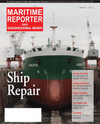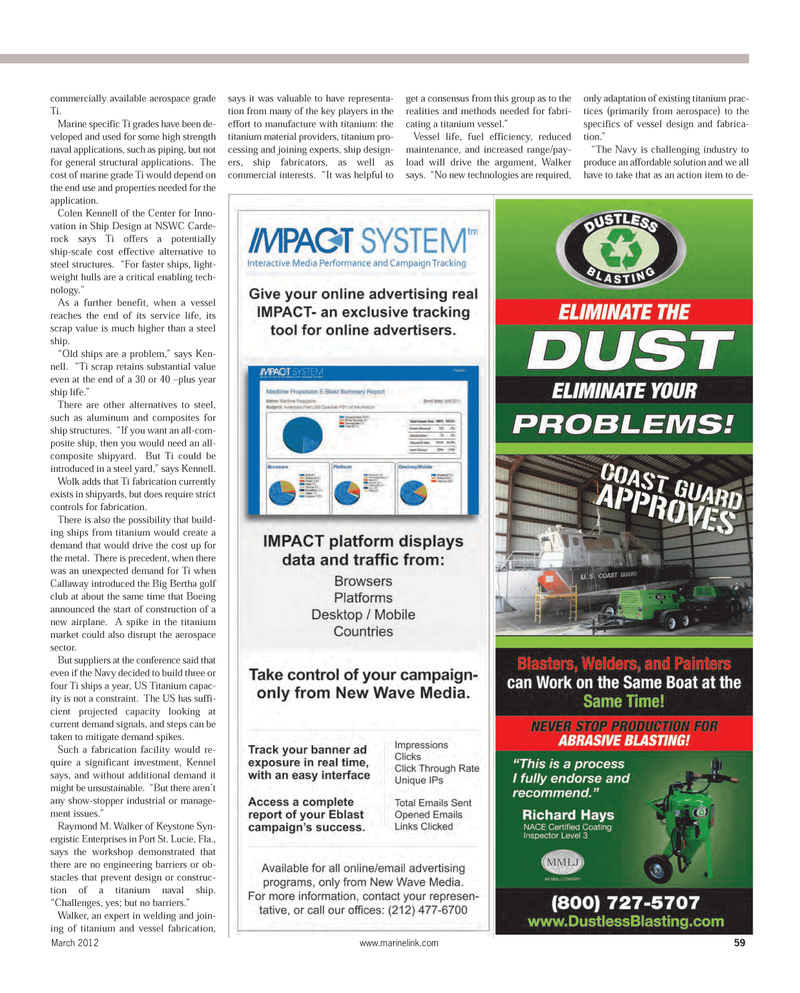
Page 59: of Maritime Reporter Magazine (March 2012)
The Ship Repair Edition
Read this page in Pdf, Flash or Html5 edition of March 2012 Maritime Reporter Magazine
commercially available aerospace grade Ti. Marine specific Ti grades have been de- veloped and used for some high strength naval applications, such as piping, but not for general structural applications. The cost of marine grade Ti would depend on the end use and properties needed for theapplication.Colen Kennell of the Center for Inno- vation in Ship Design at NSWC Carde- rock says Ti offers a potentially ship-scale cost effective alternative to steel structures. ?For faster ships, light- weight hulls are a critical enabling tech-nology." As a further benefit, when a vessel reaches the end of its service life, itsscrap value is much higher than a steel ship.?Old ships are a problem,? says Ken- nell. ?Ti scrap retains substantial value even at the end of a 30 or 40 ?plus year ship life.? There are other alternatives to steel, such as aluminum and composites forship structures. ?If you want an all-com- posite ship, then you would need an all- composite shipyard. But Ti could be introduced in a steel yard,? says Kennell. Wolk adds that Ti fabrication currently exists in shipyards, but does require strict controls for fabrication. There is also the possibility that build- ing ships from titanium would create a demand that would drive the cost up for the metal. There is precedent, when there was an unexpected demand for Ti when Callaway introduced the Big Bertha golf club at about the same time that Boeingannounced the start of construction of anew airplane. A spike in the titanium market could also disrupt the aerospace sector. But suppliers at the conference said thateven if the Navy decided to build three or four Ti ships a year, US Titanium capac- ity is not a constraint. The US has suffi- cient projected capacity looking atcurrent demand signals, and steps can betaken to mitigate demand spikes. Such a fabrication facility would re- quire a significant investment, Kennel says, and without additional demand itmight be unsustainable. ?But there aren?t any show-stopper industrial or manage- ment issues.? Raymond M. Walker of Keystone Syn- ergistic Enterprises in Port St. Lucie, Fla., says the workshop demonstrated that there are no engineering barriers or ob-stacles that prevent design or construc- tion of a titanium naval ship. ?Challenges, yes; but no barriers.? Walker, an expert in welding and join- ing of titanium and vessel fabrication, says it was valuable to have representa- tion from many of the key players in the effort to manufacture with titanium: the titanium material providers, titanium pro- cessing and joining experts, ship design- ers, ship fabricators, as well as commercial interests. ?It was helpful to get a consensus from this group as to therealities and methods needed for fabri- cating a titanium vessel.? Vessel life, fuel efficiency, reduced maintenance, and increased range/pay-load will drive the argument, Walker says. ?No new technologies are required, only adaptation of existing titanium prac- tices (primarily from aerospace) to thespecifics of vessel design and fabrica- tion.? ?The Navy is challenging industry to produce an affordable solution and we all have to take that as an action item to de- March 2012 www.marinelink.com 59MR March 12 # 8 (56-64):MR Template 3/6/2012 9:47 AM Page 59

 58
58

 60
60
